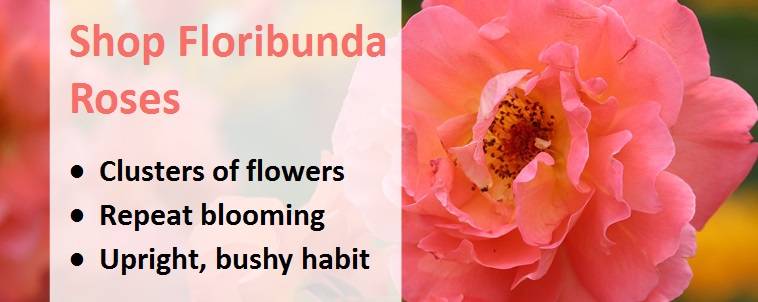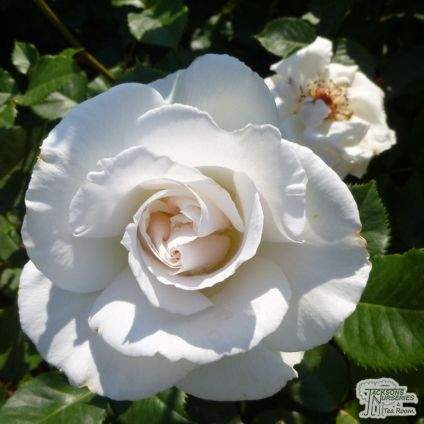Guide to Floribunda Roses
Floribundas are stiff, bushy, upright shrub roses characterised by clusters of flowers borne repeatedly from summer through autumn (as opposed to hybrid teas which typically produce flowers singly on each stem). Each flower is smaller than hybrid teas but their presence in large clusters gives an impressive floral display. They are hardy and free flowering, offering showy, fragrant blooms which are grown for display, rather than used as cut flowers as the stems are shorter than hybrid tea roses.

Floribundas were developed by cross breeding hybrid teas with polyantha roses, with the intention of creating roses which bloomed as profusely as polyanthas but with the beauty and range of colours of hybrid teas. They are smaller than a typical hybrid tea but less compact and sprawling than your usual polyantha. Blooms have the classic hybrid tea shape and are available in the same impressive range of colours, making them a great addition to a rose bed, mixed border or even a container on the patio.
Selecting a Floribunda Rose
There are a wide range of floribunda roses available in the same impressive range of colours as hybrid tea roses. Whilst selection is partly a matter of personal taste it's worth checking which roses you like the look of then considering how their eventual height and spread ties in with what you're looking to use them for. Sizes of floribunda roses vary from compact and low growing, ideal for the front of a border or small patio container, to taller varieties growing up to 1.5-1.8m (5-6 feet) which are better suited as flowering hedges. Please refer to our 'Best Floribunda Roses' section below for some ideas.

Planting Advice
When to Plant
Containerised roses can be planted at any time of the year, although from the beginning of autumn to early spring is best as this is when they are dormant. Do not plant your new floribunda rose if the ground is frozen or waterlogged. If the conditions are not appropriate, keep containerised plants in an unheated outbuilding and 'heel in' bare root roses by digging a trench in ordinary garden soil and placing the roots inside and covering with loose soil. Provide additional fleece protection if conditions are particularly harsh.

Choosing a Site
Floribunda roses like to be grown in a sunny position that is sheltered from strong winds. They will not succeed in shade or if crowded by other plants. A well-drained soil is preferred as they do not typically cope well with wet ground. If your garden naturally lies wet, incorporate some sand or coarse grid and organic matter when planting to improve drainage.

Planting
Double-dig the soil before planting to eliminate compaction and ensure it is well aerated. Dig your planting hole wide enough to comfortably accommodate the roots and deep enough so the graft will rest at soil level (to spot the graft point look for a bulge at the base of the shoots). Spread the roots across the planting hole and backfill using a mix of the dug soil plus plenty of well-rotted organic matter such as garden compost, recycled green waste or manure. We also recommend mixing in a generous helping of rose feed as roses are heavy feeders. Firm the soil down and water well.

Growing Roses in Containers
Roses also grow well in containers, which is a good option if you have a heavy clay soil or just want to add a splash of colour to the patio. Choose a deep container to accommodate the rose plants deep tap root system (except for miniatures where you will get away with a smaller pot). Choose a loam-based compost such as John Innes No 3, water well and top-dress with rose fertiliser each April. All other planting steps are the same as for growing roses in the ground (see above) but you'll need to pay special attention to feeding your rose using rose feed or another high potassium fertiliser regularly during the summer flowering period.

Garden Care
Pruning - Floribunda Roses
Correctly pruning your floribunda rose will ensure it grows vigorously and blooms well year after year. If repeatedly left unpruned, the branches of your rose bush will gradually tangle and start to look a mess. Floribunda roses are best pruned in early March just as they are starting to grow again. Make sure you have the right equipment for the job - a good pair of gardening gloves and sharp pair of secateurs are essential.
First, remove any crossing, dead, diseased or damaged stems - cut back weak stems to the base if necessary to eliminate over-crowding and create an open, goblet shape. Next, prune the remaining stems down to within 25-30cm (10 inches to 1 foot) of ground level. Finally, clear any fallen leaves and debris from around the base of the plant to keep things tidy and reduce the risk of disease and fertilise using rose feed.

Cold Protection
Most floribunda roses will require some frost protection during very cold periods and frosts in the UK as they are not fully hardy. Horticultural fleece is best, but other permeable materials also work well.
Pests and Diseases
We only sell floribunda roses with an acceptable level of disease resistance; however, no roses are completely immune. We outline some of the main problems below and how to overcome them:
- Blindness (lack of flowers) - it's not unusual for some stems to not flower every year, but a repeated lack of blooms across most stems is likely to be a sign of a problem. 'Blindness' is caused by the plant's energy being diverted, rather than being invested into blooms. The most common reason is over-exposure to harsh weather conditions or too much shade, which can be solved by providing some protection/shelter and making sure you grow your roses in a sunny site. Make sure you remove all/most of the older wood during annual pruning to encourage vigorous new shoots and cut any blind shoots back by half to a strong bud.
- Rose Aphids - greenfly, blackfly and other insects which will suck the sap from your roses. Check your roses regularly for signs of infestation on or under the leaves and on the buds. If the infestation is minor, squashing the insects may solve the problem but often an aphid bug killer spray is required.
- Black Spot - a fungal diseases evidenced by dark purple or black blotches on the leaves, which often results in leaves turning yellow or falling off the plant. The best way to deal with black spot is to collect and destroy any affected fallen leaves then use a fungus killer spray as soon as possible.
- Dieback - usually caused by a combination of inadequate care, weather conditions and pests/diseases. Prevention is easier than cure, so make sure you plant your roses in well-prepared ground that is not vulnerable to drought or water-logging, spread the roots, prune annually (particularly for dead, damaged and crossing branches), feed in spring using rose feed and water during prolonged periods of dry weather. If your plant is affected by die back, make sure you do all of the above steps and consider using a fungus killer spray if you believe this may be contributing to the problem.
Our Floribunda Roses
- Rose Absolutely Fabulous - beautiful clusters of butter yellow ruffled stunning fragrant flowers with an unusual sweet liquorice scent repeating throughout the summer.
- Rose Arthur Bell- clusters of fabulously fragrant, fully double, cupped golden-yellow blooms from July to September, gradually fading to soft creamy-yellow with age.
- Rose Birthday Girl - a small flowering floribunda rose with lightly fragranced carmine pink blooms with a distinctive cream edge produced in abundance above glossy medium green deciduous foliage.
- Rose Champagne Moment - double-cluster roses, starting apricot in the centres, fading to creamy white towards the edges as they age. Perfect for planting in a border, or as a specimen in a container or pot.
- Rose English Miss - free-flowering rose producing fully double, camellia-shaped, silver-pink blooms which are edged deeper pink and possess a wonderfully strong, sweet scent with an undertone of oriental spice.
- Rose Fragrant Delight - spectacular, large sprays of fully double, urn-shaped coppery salmon-pink blooms possessing an unparalleled fragrance emerge from pointed, upright buds between July and September.
- Rose Golden Memories - beautiful clusters of golden yellow semi double blooms amid very healthy, glossy, deciduous foliage. Continuous flowerer. Ideal for tub or planter.
- Rose Golden Wedding - fantastic, large-flowering variety producing rich, golden yellow blooms which are set off beautifully against a plentiful display of attractive, glossy dark green deciduous leaves.
- Rose Hot Chocolate - stunning clusters of rusty orange buds, opening to a rich velvety brown blend strong fragrance flowers repeating throughout the summer.
- Rose Iceberg - sweetly-scented sprays of flat, bright white flowers emerge from shapely pink-tinged buds.
- Rose Irish Eyes - beautiful, fully double, cupped, vibrant yellow blooms with a bold flush of orangey-red at the edge of each petal.
- Rose Korresia - easy-to-grow, large flowering floribunda bush producing sweetly scented, fully double, bright yellow blooms in loose, showy clusters.
- Rose Many Happy Returns - rose pink flowers are borne on long, thorn free shoots. Fragrant blooms. Award winner. Ideal present for birthday celebration or anniversary.
- Rose Margaret Merril - high-centred, fully double, delicate pearly-white blooms possessing an exquisite fragrance are produced in showy clusters.
- Rose Princess of Wales - cream base leading to varying shades of pale pink-each rose is slightly different.
- Rose Remembrance - bright scarlet blooms above dark green deciduous foliage. Disease resistant.
|
|
|
|
|
- Rose Rhapsody in Blue - large, loosely double, deep purple blooms which possess a delicious, fruity-floral scent and gently darken to slate-blue as they mature.
-
Plant Guides
- Guide to Bamboo Plants
- Guide to Climbing Plants
- Guide to Climbing Roses
- Guide to Conifers
- Guide to Floribunda Roses
- Guide to Fruit Bushes
- Guide to Fruit Trees
- Guide to Garden Ferns
- Guide to Garden Shrubs
- Guide to Heather Plants
- Guide to Hedging Plants
- Guide to Herb Plants
- Guide to Herbaceous Perennials
- Guide to Hybrid Tea Roses
- Guide to Japanese Maple Trees
- Guide to Ornamental Grasses
- Guide to Rhododendrons
- Guide to Topiary
Share this page:






















